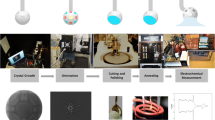Abstract
An improved test for rapid determination of the efficacy of additives systems for use in bottom-up copper metallization of micro- and nano-scale features is introduced as a replacement for the classical injection technique. The conventional injection test is based on measuring the polarization response to the injection of an additive into a solution in which a rotating disk electrode is plated at a moderate constant current density of about 10 mA cm−2. The inaccurate assumptions underlying this test and its limitations are discussed. The modified screening technique introduced here is based on the recognition that bottom-up metallization of micro- and nano-scale features is carried out at a constant overpotential where the current density at the inhibited regions of the feature is significantly lower, on the order of 1 mA cm−2. A single polarization measurement at this low current density in an electrolyte containing the tested suppressors is suggested. The suppressors exhibiting the largest overpotentials are considered promising and should be selected for further characterization.







Similar content being viewed by others
Abbreviations
- E :
-
Standard potential
- F :
-
Faraday’s constant
- i :
-
Current density
- \(i_{\text{B}}\) :
-
Current density at feature bottom
- \(i_{\text{L}}\) :
-
Limiting current density
- \(i_{\text{T}}\) :
-
Current density at feature rim and top of wafer
- L :
-
Feature depth
- n :
-
Number of electrons transferred
- r :
-
Radius of working electrode
- R :
-
Feature radius
- R g :
-
Universal gas constant
- T :
-
Temperature
- V :
-
Applied potential
- \(\eta_{\text{a}}\) :
-
Activation overpotential
- \(\eta_{\text{c}}\) :
-
Concentration overpotential
- \(\eta_{\varOmega}\) :
-
Ohmic overpotential
- \(\eta_{\text{B}}\) :
-
Overpotential at feature bottom
- \(\eta_{\text{T}}\) :
-
Overpotential at feature rim and top surface
- κ :
-
Electrolyte conductivity
- Φ:
-
Electrostatic potential in solution
- ΦB :
-
Electrostatic potential in solution at feature bottom
- ΦT :
-
Electrostatic potential in solution at feature top
References
Andricacos PC, Uzoh C, Dukovic JO, Horkans J, Deligianni H (1998) Damascene copper electroplating for chip interconnections. IBM J Res Dev 42:567–574
Healy JP, Pletcher D, Goodenough M (1992) The chemistry of the additives in an acid copper electroplating bath. 1. Polyethylene-glycol and chloride-ion. J Electroanal Chem 338:155–165
Kelly JJ, West AC (1998) Copper deposition in the presence of polyethylene glycol—I. Quartz crystal microbalance study. J Electrochem Soc 145:3472–3476
Kelly JJ, West AC (1998) Copper deposition in the presence of polyethylene glycol—II. Electrochemical impedance spectroscopy. J Electrochem Soc 145:3477–3481
Feng ZV, Li X, Gewirth AA (2003) Inhibition due to the interaction of polyethylene glycol, chloride, and copper in plating baths: a surface-enhanced Raman study. J Phys Chem B 107:9415–9423
Doblhofer K, Wasle S, Soares DM, Weil KG, Ertl G (2003) An EQCM study of the electrochemical copper-(II)/copper(I)/copper system in the presence of PEG and chloride ions. J Electrochem Soc 150:C657–C664
Kondo K, Matsumoto T, Watanabe K (2004) Role of additives for copper damascene electrodeposition experimental study on inhibition and acceleration effects. J Electrochem Soc 151:C250–C255
Hebert KR (2005) Role of chloride ions in suppression of copper electrodeposition by polyethylene glycol. J Electrochem Soc 152:C283–C287
Cao Y, Taephaisitphongse P, Chalupa R, West AC (2001) Three-additive model of superfilling of copper. J Electrochem Soc 148:C466–C472
Georgiadou M, Veyret D, Sani RL, Alkire RC (2001) Simulation of shape evolution during electrodeposition of copper in the presence of additive. J Electrochem Soc 148:C54–C58
West AC, Mayer S, Reid J (2001) A superfilling model that predicts bump formation. Electrochem Solid-State Lett 4:C50–C53
Moffat TP, Wheeler D, Huber WH, Josell D (2001) Superconformal electrodeposition of copper. Electrochem Solid-State Lett 4:C26–C29
Josell D, Wheeler D, Huber WH, Bonevich JE, Moffat TP (2001) A simple equation for predicting superconformal electrodeposition in submicrometer trenches. J Electrochem Soc 148:C767–C773
Akolkar R, Landau U (2004) A time-dependent transport-kinetics model for additive interactions in copper interconnect metallization. J Electrochem Soc 151:C702–C711
Moffat TP, Wheeler D, Edelstein MD, Josell D (2005) Superconformal film growth: mechanism and quantification. IBM J Res Dev 49:19–36
Dow WP, Yen MY, Lin WB, Ho SW (2005) Influence of molecular weight of polyethylene glycol on microvia filling by copper electroplating. J Electrochem Soc 152:C769–C775
Akolkar R, Landau U (2009) Mechanistic analysis of the “bottom-up” fill in copper interconnect metallization. J Electrochem Soc 156:D351–D359
Mendez J, Akolkar R, Landau U (2009) Polyether suppressors enabling copper metallization of high aspect ratio interconnects. J Electrochem Soc 156:D474–D479
Adolf J, Landau U (2011) Predictive analytical fill model of interconnect metallization providing optimal additives concentrations. J Electrochem Soc 158:D469–D476
Huang Q, Baker-O’Neal BC, Kelly JJ, Broekmann P, Wirth A, Emnet C, Martin M, Hahn M, Wagner A, Mayer D (2009) Suppressor effects during copper superfilling of sub-100 nm lines. Electrochem Solid-State Lett 12:D27–D31
Huang Q, Liu J, Baker-O’Neal B (2014) An electrochemical method of suppressor screening for Cu plating in sub-100 nm lines. J Electrochem Soc 161:D207–D213
Ryan K, Dunn K, van Eisden J (2012) Development of electrochemical copper deposition screening methodologies for next generation additive selection. Microelectron Eng 92:91–94
Bard AJ, Faulkner LR (2001) Electrochemical methods: fundamentals and applications, 2nd edn. Wiley, New York, p 339
Newman J (1966) Resistance for flow of current to a disk. J Electrochem Soc 113:501–502
Boehme L, Landau U (2013) Screening techniques for selecting improved additives for bottom-up copper metallization. Abstract #2087, 224th ECS Meeting, San Francisco, CA
Boehme L (2014) Additives screening techniques and process characterization for electroplating semiconductor interconnects. PhD Dissertation, Case Western Reserve University
Acknowledgments
The authors gratefully acknowledge support from Atotech for this work. Coupon plating studies were assisted by Jun Wu (Atotech).
Author information
Authors and Affiliations
Corresponding author
Rights and permissions
About this article
Cite this article
Boehme, L., Landau, U. Rapid screening of plating additives for bottom-up metallization of nano-scale features. J Appl Electrochem 46, 39–46 (2016). https://doi.org/10.1007/s10800-015-0873-5
Received:
Accepted:
Published:
Issue Date:
DOI: https://doi.org/10.1007/s10800-015-0873-5




